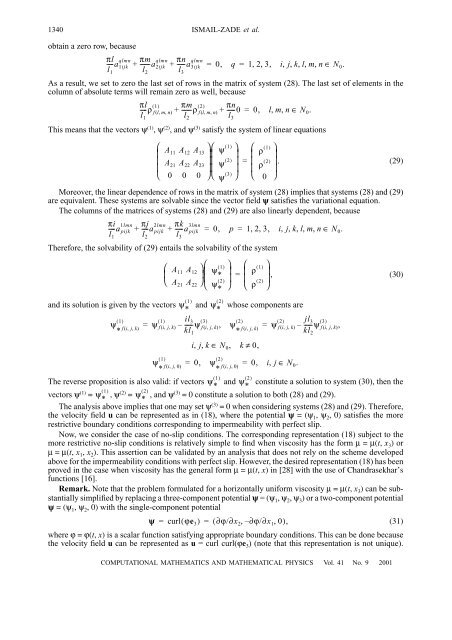Numerical Simulation of Three-Dimensional Viscous Flows with ...
Numerical Simulation of Three-Dimensional Viscous Flows with ...
Numerical Simulation of Three-Dimensional Viscous Flows with ...
Create successful ePaper yourself
Turn your PDF publications into a flip-book with our unique Google optimized e-Paper software.
1340<br />
ISMAIL-ZADE et al.<br />
obtain a zero row, because<br />
πl qlmn<br />
----a<br />
l 1ijk<br />
1<br />
πm qlmn πn qlmn<br />
+ ------- a 2ijk + ----- a 3ijk = 0, q = 123, , , ijklmn , , , , , ∈ N 0 .<br />
l 2<br />
As a result, we set to zero the last set <strong>of</strong> rows in the matrix <strong>of</strong> system (28). The last set <strong>of</strong> elements in the<br />
column <strong>of</strong> absolute terms will remain zero as well, because<br />
πl 1<br />
----ρ<br />
l flmn , ,<br />
1<br />
This means that the vectors ψ (1) , ψ (2) , and ψ (3) satisfy the system <strong>of</strong> linear equations<br />
Moreover, the linear dependence <strong>of</strong> rows in the matrix <strong>of</strong> system (28) implies that systems (28) and (29)<br />
are equivalent. These systems are solvable since the vector field y satisfies the variational equation.<br />
The columns <strong>of</strong> the matrices <strong>of</strong> systems (28) and (29) are also linearly dependent, because<br />
πi 1lmn<br />
----a<br />
l pijk<br />
1<br />
Therefore, the solvability <strong>of</strong> (29) entails the solvability <strong>of</strong> the system<br />
l 3<br />
( ) πm<br />
( )<br />
l 2<br />
( 2) πn<br />
l 3<br />
+ ------- ρ flmn ( , , ) + ----- 0 = 0, lmn , , ∈ N 0 .<br />
⎛ A 11 A 12 A ⎞⎛<br />
13 ψ ( 1)<br />
⎞<br />
⎜<br />
⎟⎜<br />
⎟<br />
⎜ A 21 A 22 A<br />
⎜<br />
23<br />
⎟⎜<br />
ψ ( 2)<br />
⎟ =<br />
⎟⎜<br />
⎟<br />
⎝ 0 0 0 ⎠⎝<br />
⎠<br />
ψ ( 3)<br />
⎛<br />
⎜<br />
⎜<br />
⎜<br />
⎝<br />
ρ ( 1)<br />
ρ ( 2)<br />
πj 2lmn πk 3lmn<br />
+ ----a pijk + -----a pijk = 0, p = 123, , , ijklmn , , , , , ∈ N 0 .<br />
l 2<br />
l 3<br />
0<br />
⎞<br />
⎟<br />
⎟.<br />
⎟<br />
⎠<br />
(29)<br />
⎛ A 11 A 12<br />
⎞<br />
⎛ ( 1)<br />
⎞<br />
⎜ ⎟<br />
⎜ ψ *<br />
⎟<br />
⎝ A 21 A 22 ⎠<br />
⎜ ( 2)<br />
⎟<br />
⎝ ψ * ⎠<br />
=<br />
⎛<br />
⎜<br />
⎜<br />
⎝<br />
ρ ( 1)<br />
ρ ( 2)<br />
⎞<br />
⎟,<br />
⎟<br />
⎠<br />
(30)<br />
( 1)<br />
( 2)<br />
and its solution is given by the vectors ψ and ψ whose components are<br />
* *<br />
( 1)<br />
( )<br />
ψ *<br />
fi, jk ,<br />
( 1) il<br />
ψ 3<br />
fi ( , jk , )<br />
( 3)<br />
( 2)<br />
= – ------ ψ<br />
kl fi ( , jk , ) , ψ = ψ<br />
1<br />
*<br />
fi ( , jk , ) fi, jk ,<br />
i, j,<br />
k ∈ N 0 , k ≠ 0,<br />
( 2) jl 3<br />
( ) –<br />
( 3)<br />
------ ψ<br />
kl fi ( , jk , ) ,<br />
2<br />
( 1)<br />
( )<br />
ψ *<br />
fi, j0 ,<br />
( 2)<br />
= 0, ψ = *<br />
fi ( , j0 , )<br />
0, i,<br />
j ∈ N 0 .<br />
( 1)<br />
( 2)<br />
The reverse proposition is also valid: if vectors ψ and ψ constitute a solution to system (30), then the<br />
* *<br />
vectors ψ (1) ( 1)<br />
= , ψ (2) ( 2)<br />
ψ = ψ , and ψ (3) = 0 constitute a solution to both (28) and (29).<br />
* *<br />
The analysis above implies that one may set ψ (3) = 0 when considering systems (28) and (29). Therefore,<br />
the velocity field u can be represented as in (18), where the potential y = (ψ 1 , ψ 2 , 0) satisfies the more<br />
restrictive boundary conditions corresponding to impermeability <strong>with</strong> perfect slip.<br />
Now, we consider the case <strong>of</strong> no-slip conditions. The corresponding representation (18) subject to the<br />
more restrictive no-slip conditions is relatively simple to find when viscosity has the form µ = µ(t, x 3 ) or<br />
µ = µ(t, x 1 , x 2 ). This assertion can be validated by an analysis that does not rely on the scheme developed<br />
above for the impermeability conditions <strong>with</strong> perfect slip. However, the desired representation (18) has been<br />
proved in the case when viscosity has the general form µ = µ(t, x) in [28] <strong>with</strong> the use <strong>of</strong> Chandrasekhar’s<br />
functions [16].<br />
Remark. Note that the problem formulated for a horizontally uniform viscosity µ = µ(t, x 3 ) can be substantially<br />
simplified by replacing a three-component potential y = (ψ 1 , ψ 2 , ψ 3 ) or a two-component potential<br />
y = (ψ 1 , ψ 2 , 0) <strong>with</strong> the single-component potential<br />
y = curl( ϕe 3 ) = ( ∂ϕ/∂x 2 , – ∂ϕ/∂x 1 , 0),<br />
(31)<br />
where ϕ = ϕ(t, x) is a scalar function satisfying appropriate boundary conditions. This can be done because<br />
the velocity field u can be represented as u = curl curl(ϕe 3 ) (note that this representation is not unique).<br />
COMPUTATIONAL MATHEMATICS AND MATHEMATICAL PHYSICS Vol. 41 No. 9 2001



